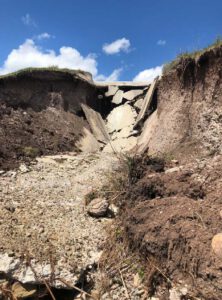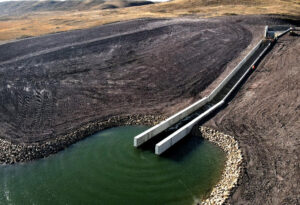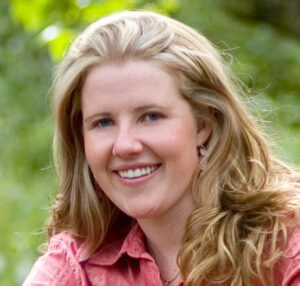On May 17, 2020, a drop structure on the Milk River Project, which conveys water to the Milk River in Montana’s Hi-Line Region, failed catastrophically, eliminating or significantly reducing irrigation water flows across the Milk River basin. The Milk River Joint Board of Control (MRJBOC), the State of Montana, the Bureau of Reclamation, and other stakeholders immediately sprang into action, assessing the site, modifying existing plans, and beginning construction in August. By early October, water was flowing through the project’s infrastructure once again. In this interview, MRJBOC Program Manager Jennifer Patrick and Marko Manoukian, the Montana State University extension agent in Phillips County and the local chairperson for the St. Mary’s Rehabilitation Working Group, tell Irrigation Leader about how they addressed this emergency situation and their outlook for the future.
Irrigation Leader: Please tell us about the drop 5 failure that occurred in May 2020.
Jennifer Patrick: At approximately 3:00 p.m. on Sunday, May 17, the concrete drop structure on the St. Mary Canal known as drop 5 failed. Drop 5 is located northwest of the town of Cut Bank on the Blackfeet Reservation. The failure of drop 5 left the entire Milk River basin without supplemental water for the rest of the irrigation season.
We do not know what happened in technical terms. To me, it looked like a bomb had been placed under the middle section of the drop structure. More than half the structure was gone, and there was a large hole where water washed a significant amount of material downstream. We discussed temporary fixes to the structure and other interim measures, but by the time they would have been implemented, the costs would have outweighed the benefits.
Irrigation Leader: How did you decide what action to take at that point?

Jennifer Patrick: Reclamation had people on the ground on Monday morning. We sent personnel from HDR Engineering, including Stan Schweissing, who eventually took lead on the project, to assess the structure the next day. Then the MRJBOC, Reclamation, and the State of Montana held a conference call to discuss our next steps. We started talking to contractors about the time frame for a partial or full replacement of the structure. Reclamation started running the numbers on the possibility of piping water around the collapsed structure. It’s right next to a wetland, so we had to take that into consideration. Reclamation’s technical service compiled information on all these interim options. We looked at both rehabilitation and replacement. On June 4, the MRJBOC made the decision to assume operations and maintenance of the drop 5 structure and do a full replacement. We also decided to fully replace drop 2.
Irrigation Leader: Please tell us about the design and construction process.
Jennifer Patrick: We had already planned to do construction on drop 2 in 2020–2021, so we had 90 percent of the engineering for drop 2 completed and in hand. The drop 2 and drop 5 structures are similar, despite the topography of the land around them being different. HDR’s team was wonderful and quickly modified the drop 2 design for drop 5, which is about 100 feet longer. Terracon had previously performed the geotechnical assessments on drop 2, so Brian Williams was familiar with the area. He rearranged his schedule and came on site a week after the failure to make an initial assessment of the soils and perform exploratory drilling. The engineering was a large joint effort between the MRJBOC, HDR, and Reclamation. HDR led the design, but there were daily conversations on the decisions. The Blackfeet Tribe also worked closely with Reclamation on all environmental and cultural compliance issues. On the construction side, Sletten Construction Company was the lead contractor; it received support from the Blackfeet Tribal Employment Office and M&D Construction.

Irrigation Leader: When did construction begin?
Jennifer Patrick: On June 22, Sletten Construction mobilized on site. Work on drop 2 started first, since there was extensive cleanup and permitting to complete at drop 5. The first concrete placement on drop 2 occurred on July 23, and the first concrete was placed on drop 5 on August 19. We finished all construction on October 5, and water was turned back on on October 8. Sletten and its team were excellent to work with. Two of the guys in the Sletten office, Thad Pederson and Matt Poppa, and their shop manager had a real nightmare working through all the logistics of getting material to site to keep the crews happy. We had many challenges during construction, but from my perspective, we tackled it as a team, and the outcome of turning water on 22 weeks after a failure, in a remote location and in the middle of a pandemic, is impressive.
Irrigation Leader: How did the drop 5 failure affect operations for the remainder of the year?
Jennifer Patrick: We had a full pool in Fresno, which allowed the Milk River irrigators to carry out one round of irrigation, although it was half the water they usually get. The users along the canal, the users in Canada, and the users above Fresno do not have offsite storage facilities like the one in Fresno. Those users include the Canadian towns of Milk River and Coutts and the town of Sweet Grass, Montana. They do have some minimal storage in their facilities, but they had to ration for most of the summer. The flow in the Milk River in that area was 3 cubic feet per second at most. You could jump over it.
Marko Manoukian: As Jenn pointed out, there was enough water for one round of irrigation, and we had a normal-to-dry July and August, which didn’t help crop production at all.
Irrigation Leader: What was the rough cost of this project, and who paid for it?
Jennifer Patrick: The estimated cost was $8 million. We came in under budget, but we are still wrapping things up. We applied for extraordinary/emergency maintenance funds under Public Law 111‑11 and were approved by Reclamation Commissioner Burman. That replaced our normal 25/75 cost share with a 50/50 split. The St. Mary Rehabilitation Working Group had secured a bond with the state legislature in 2007, but it could only be used on the condition that the federal government entered into a cost-share agreement that was more favorable than our existing operation and maintenance agreement. That meant that the bond had been sitting there since 2007, unable to be used, until we got the 50/50 cost share. The bond funding covered the majority of the nonfederal half of the project funding. The State of Montana and the Montana Department of Natural Resources and Conservation (DNRC) were able to contribute a large portion of the funds, in addition to two DNRC grants and two Growth Through Agriculture grants from the State of Montana. The irrigators, pumpers, and municipalities also contributed, as did the working group. Funding this project was a basinwide effort.
Although we did not have a congressional act or cost-share change, Senators Tester and Daines and Congressman Gianforte worked behind the scenes on some critical logistics. The Montana state delegation and the governor’s office were also supportive.
Irrigation Leader: Your project is located on the border with Canada and delivers water that goes to Canadian users. Was there an international aspect to this project, either in terms of funding or of coordination?
Jennifer Patrick: Financially, no, but there was some logistical coordination. The United States and Canada worked to clear concrete trucks through a border crossing gate, helping them avoid a round trip of more than 2 hours. That was a big deal, since with COVID‑19, the border is closed to a lot of travel.
Irrigation Leader: What was the role of the Blackfeet Nation in this project?
Jennifer Patrick: After the failure, we immediately informed the tribe. The landowners who live along the canal are also tribal members. They were in touch with us and the Tribal Council.
We contracted with the tribe to help us with the cultural and environment permitting. During construction, we coordinated with the Tribal Employment Rights Office. The ladies in that office worked diligently to send us crew and specialized laborers. There was quite a bit of coordination, especially since most workers had to travel more than an hour daily. The Tribal Council was also supportive. Initially, when the failure happened, the DNRC was able to provide some grant funding to the Blackfeet Tribe to engage its engineer and compact team members in the project. Those members—Lyle Meeks, Gerald Lunak, and Jeanne Whiteing—provided invaluable information and coordination as we navigated the failure.
Considering the extensive travel to site on gravel roads, I need to mention one of our most important partners, Rumney Ranch, which allowed us to set up a man camp to minimize travel to site, allowing us to increase production. It was my experience that the entire Blackfeet Nation was more than willing to help us however it could.
Irrigation Leader: What was the role of the St. Mary Rehabilitation Working Group?
Jennifer Patrick: The St. Mary Rehabilitation Working Group may have taken a back seat in the day-to-day construction, but the project would not have happened without it. The bond funding and the drop 2 engineering designs were vital components of the project that the working group had previously worked on. For me personally, the relationships that the group cultivated over the years were among the most important things that helped me navigate the project. We were able to call on many people who have been involved in these issues for a long time, such as Gerald Lunak. The ground work the working group laid needs to be recognized.
Marko Manoukian: The whole reason that the St. Mary Rehabilitation Working Group was formed was to avoid a catastrophic failure like the one that happened at drop 5. We have met regularly with our congressional delegation to try to find a larger chunk of money to address some of these issues. In April, we had been talking about rehabilitating a diversion structure as well as drops 2 and 5. Now, obviously, drops 2 and 5 have been rebuilt, but we still have a diversion structure that will cost upward of $40–$50 million to be repaired. We are working continually with our congressional staff to identify the language we need and the appropriations we need to make that happen. We want to start with a cost share adjusted to reflect the normal cost of these projects, the fact that the diversion structure serves a broader audience than it was originally intended to, and the burden of complying with endangered species regulations. We still haven’t gotten federal legislation to address this. We also need large sums of money to address things like siphons and Fresno Dam. We continue to work with our delegation to figure out how to do that.
Irrigation Leader: What are the next steps for the Milk River Project?
Marko Manoukian: If we could get a 75/25 cost share on the diversion dam structure, that would be terrific. We’d still struggle to find 25 percent of the cost of a $50 million project, but that cost-share breakdown would get us a lot closer. We’ve shown that the work can be successfully done in a short time frame. I hope that that will make the next step easier.
Irrigation Leader: What are the most important lessons you learned from the replacement of drops 2 and 5?
Jennifer Patrick: Don’t put off infrastructure work that you could have done 10 years ago. We also learned that we’re not in this alone. The MRJBOC, the St. Mary Rehabilitation Working Group, 10 Canadian agencies, and 40 U.S. agencies were involved in addressing this failure. There are people willing to step up and help on this. That’s a big deal going forward, because as Marko said, we’re not done. We have more than $200 million worth of projects that need attention.
Marko Manoukian: I hope we don’t have to wait for another catastrophe to do something. I hope we can start to address these critical infrastructure needs more proactively. There’s no resounding chorus in Congress for addressing our failed infrastructure, which the country gets a D+ for. That’s unfortunate and I hope it changes, although I’m a little cynical about whether it will.
Jennifer Patrick: There is one other thing I’ve learned from this project: Surround yourself with great people who have the same common goal, and you won’t fail. There was not a person on this team from finance to onsite construction who didn’t want to see water turned on. It was an incredible project to be a part of. Everyone set their personal agendas and politics aside for a common goal. I would work with this team again in a heartbeat.
 Jennifer Patrick is the program manager of the Milk River Joint Board of Control. She can be contacted at jenn@mrjboc.com or (406) 945‑3383.
Jennifer Patrick is the program manager of the Milk River Joint Board of Control. She can be contacted at jenn@mrjboc.com or (406) 945‑3383.

Marko Manoukian is the Montana State University extension agent in Phillips County and the local chairperson for the St. Mary Rehabilitation Working Group. He can be contacted at pcextn@mtintouch.net or (406) 654‑2543.
